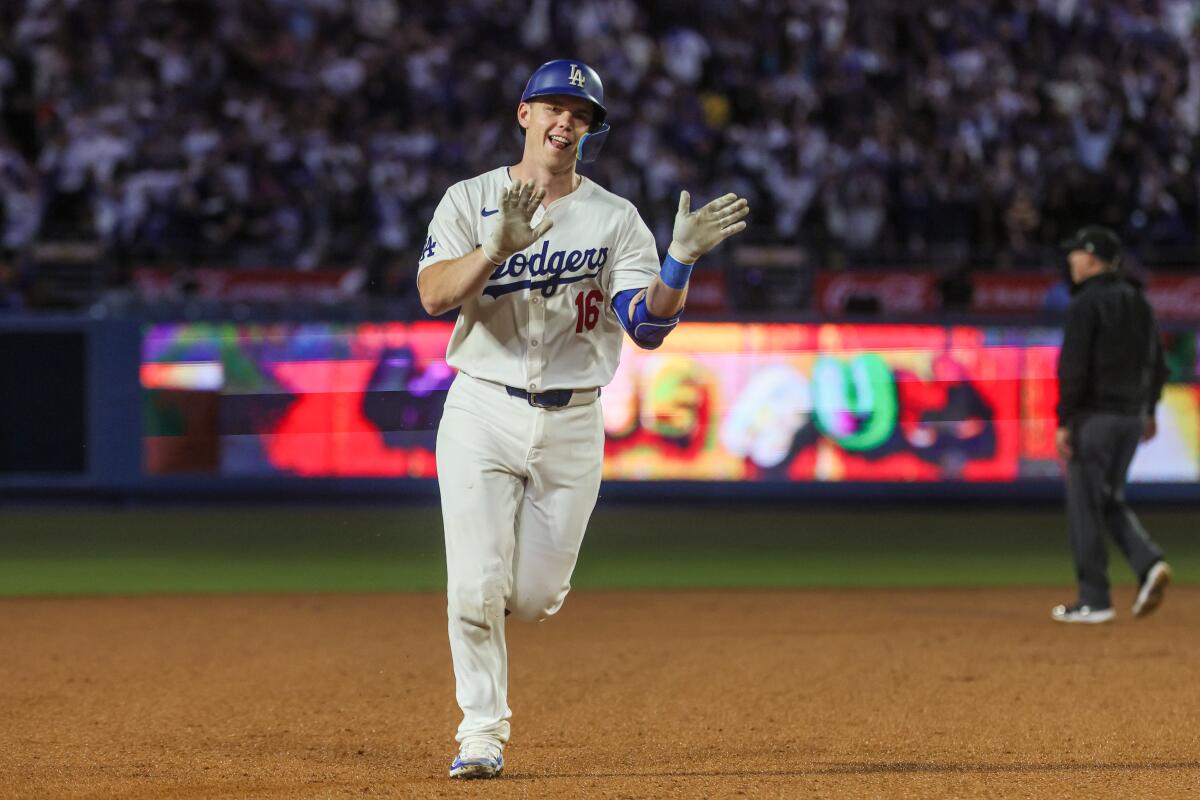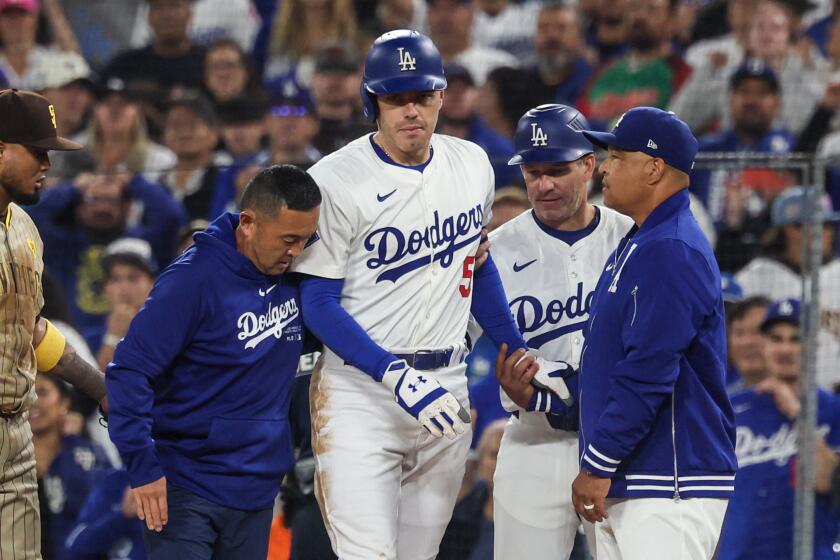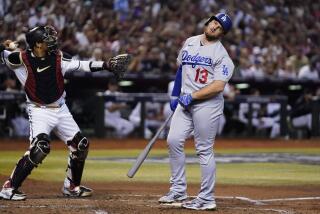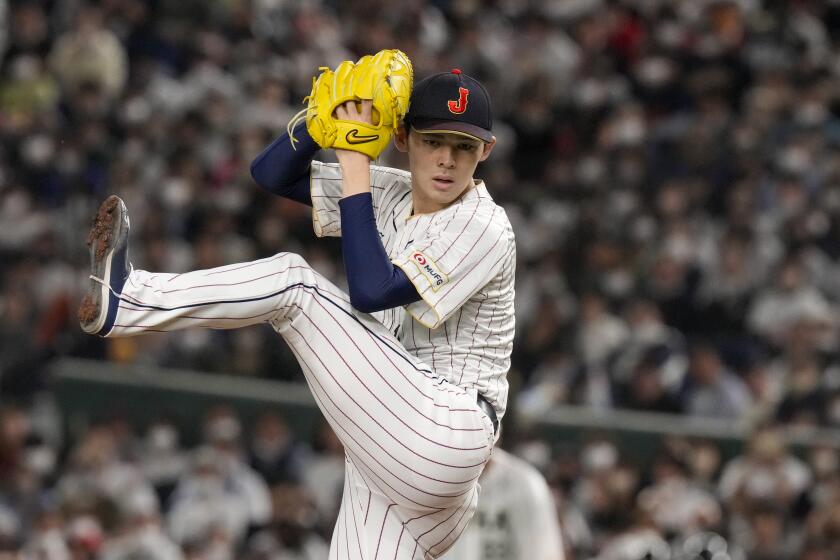After ‘long funk’ and struggles with fastballs, has Will Smith rediscovered his swing?

- Share via
DENVER — Will Smith has hardly been a bad hitter for the Dodgers during the past two seasons.
But as his offensive production has declined at the plate, with the sixth-year catcher setting career lows for OPS in back-to-back campaigns, there’s been one common denominator to what he’s been missing.
From 2020 to 2022, Smith did much of his damage against four-seam fastballs, batting .292 against the pitch with a .588 slugging percentage, 21 home runs and only an 18.6% whiff rate.
In 2023 and 2024, however, those numbers have dipped across the board: Smith has only hit four-seamers at a .214 clip. He has slugged just .383 against them. And as pitchers have started throwing him more heaters, his whiff rate has climbed to 23.9%.
Freddie Freeman sustained a sprained ankle in the Dodgers’ win over the Padres on Thursday, but the team is confident he will play in the postseason.
Overall, he’s still an above-league-average hitter, posting a .246 batting average this year with 20 home runs, 74 RBIs and a .758 OPS.
But the statistical regression has illustrated his struggles to hone in on his best swing — one the Dodgers are hoping has started to reappear in recent weeks.
This is what made Smith’s home run in the Dodgers’ division-clinching win on Thursday such a notable sight. It wasn’t just that he tied their game against the rival San Diego Padres, helping spark a go-ahead rally in the bottom of the seventh. Or that he celebrated with a demonstrative two-hand bat flip, displaying as much emotion as manager Dave Roberts could remember since his iconic long ball in the 2020 National League Championship Series.
Rather, the biggest thing is that it came against a Joe Musgrove four-seamer, with Smith barreling up an elevated 3-and-1 heater — the kind he has so often missed or fouled back or hit weakly for an out the last two seasons — and launching it to straightaway center at an estimated distance of 426 feet.
“That was a big boy home run,” Roberts declared afterward.
“Got into a hitter’s count,” a booze-soaked but understated Smith added amid the postgame clubhouse celebration, “and put a good swing on it.”
Early in his career, Smith had little trouble manufacturing such moments. In his rise as one of the majors’ most productive offensive catchers — an ascent that culminated with a 10-year, $140-million contract extension with the Dodgers before this season — his ability to punish fastballs was among his defining strengths.
But ever since he suffered a broken rib and oblique strain in late April of last season, the 29-year-old slugger has been inconsistent with his swing mechanics, according to Dodgers hitting coach Aaron Bates.
“I would just say some bad habits crept in from the injuries,” Bates explained. “They were so small, but they bled over into the next year.”
The Dodgers defeat the San Diego Padres 7-2 to clinch another NL West title, but Freddie Freeman rolls his ankle in another potential cause for concern.
At times, Smith has been able to work around it. He earned his first All-Star selection last year while playing through the ailments. He was selected to the Midsummer Classic again this season after a torrid performance in March and April (.362 batting average, 13 extra-base hits, 23 RBIs) that Bates credited to his ability to attack off-speed pitches.
“Obviously,” Bates said, “he’s had some games this year where he’s been really good.”
Smith’s struggles against the fastball, however, quickly became a weakness for opposing pitchers to exploit. From May to August, he didn’t hit better than .212 in a single month. During that stretch, his average against fastballs was a woeful .146.
“His hands were creeping down as he was striding [toward the ball],” Bates said, identifying one of the core habits Smith and the Dodgers have tried to eliminate from his swing. “Guys are different, but most hitters for the most part want to feel like they’re above the ball and can work from the top down. If you’re working from the waist up or are caught in-between, you’re just trying to guess. It can be a tough spot.”
Attempting to fix his swing this year has forced Smith to revisit the past. His work in the batting cage has focused on “getting back to probably more of the ‘21, ‘22 [version of] myself,” he said recently. “More that model, if you want to say, where I was really hitting the heater.”
“I got away from a little bit of stuff last year, just trying to figure out what works,” Smith added, when asked how the lingering effects of last year’s injuries have manifested at the plate. “Sometimes you make the wrong changes. But the beginning of the last two years has been really good. So, it’s just, ‘Is that mold right for me?’ ”
Smith has appeared to start finding an answer again lately, just in time for a Dodgers’ postseason run that will likely hinge on the consistency of their lineup.
Since the start of September, he is hitting .254 with a .460 slugging percentage. His production against fastballs has skyrocketed as well, batting nine for 20 against the pitch this month.
“He’s coming to life [and taking] better at-bats,” Roberts said last week. “I think mechanically he’s in a good spot … And I think that he got through that funk that he was in, that long funk. I like where he’s at.”
Mookie Betts took about 300-400 swings before he faced the Padres on Thursday night at Dodger Stadium, helping him finally break through at the plate.
This could all have massive ramifications on the Dodgers’ chances in the playoffs, of course, with Smith still occupying a critical role in the lineup. He’s no longer the team’s clean-up hitter, as he was early in the season. But he’s still had ample run-producing opportunities, averaging the second-most plate appearances with runners in scoring position on the team per game (only Teoscar Hernández comes up in such spots more often).
“He’s such a pro, and he’s such a great player,” Bates said. “I think the way he’s performed [lately] is more in-tune with the player he is.”
If that wasn’t becoming clear already, Thursday’s long ball brought it auspiciously into focus.
“For Will to hit a big boy home run right there gave us a lot of life,” Roberts said. “That was a lot of pressure and angst off his shoulders tonight.”
More to Read
Are you a true-blue fan?
Get our Dodgers Dugout newsletter for insights, news and much more.
You may occasionally receive promotional content from the Los Angeles Times.












